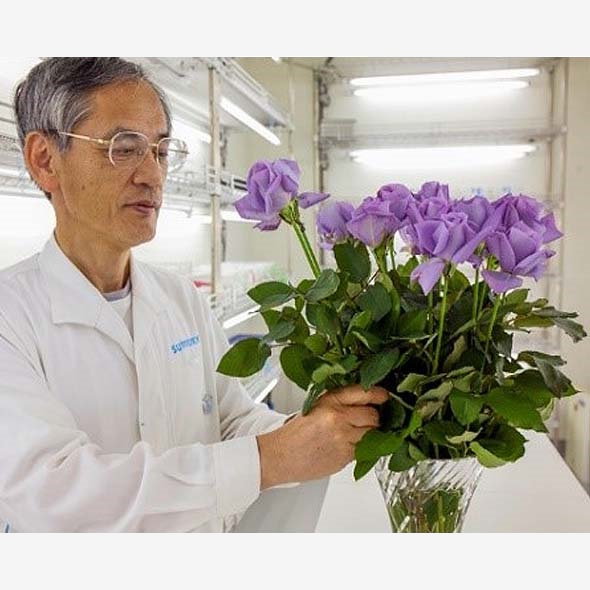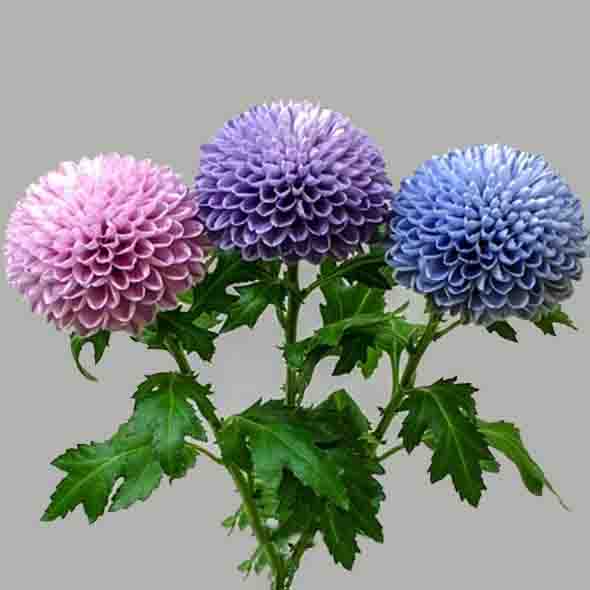By Kai Kupferschmidt [1,2]
The favorite color of most people, however hardly common among animals and plants. It is very difficult to produce artificially. Consequently, scientists are eagerly working on creating new blue pigments.
Part 2: The Impossible Flower
Since romanticism the blue flower has been a symbol for longing and the unreachable. No matter what has been tried, the perfect blue flower is still far away.
The first blue rose was introduced to the public by the Japanese researcher Yoshikazu Tanaka and his staff in 2004. The only problem: it wasn’t that blue. Although its flower petals produced a blue pigment, the rose itself appeared purple. Tanaka himself admitted that the rose could have been “more blue”.
Still searching for the blue rose Tanaka now is working in the research lab of the beverage company called Suntory, also Japan’s first whiskey distillery. The tax increase in the 1980s caused the company to enter the flower market. Company legend has it that the English Rose of Suntory should have had the Scottish national color blue to celebrate the invention of whiskey.
It turned out to be a smart marketing idea for there are hardly any blue flowers besides artificially ones like blue orchids. Chrysanthemums, carnations, tulips - none of them naturally come in blue. The same is true for blue orchids, which have usually been artificially dyed. Roses are only common in various shades of yellow, pink and red.

Artists have known this fact for a long time. In romanticism, the blue flower was symbol for yearning and the unreachable. Rudyard Kipling wrote a poem about a man who was in search of a blue rose for his beloved: “Half the world I wandered through seeking where such flowers grew.” After his return empty handed his great love has died.
The complexity of the blue blossoms became evident for the first time in 1913. German scientist Richard Willstätter allegedly isolated the blue pigment from cornflowers. It was an anthocyanin, which he named cyanidin. Two years later, he performed the same procedure on red roses and it turned out to be the same molecule. Anthocyanins can change color depending on the acidity of a solution, so Willstätter proposed that roses had a different hue because the pH in their petals was lower than in cornflowers.
This first scientific thesis about blue flowers turned out to be utterly incorrect. It took decades until finally in 2005 an x-ray crystallography confirmed a different statement. A solid blue color is not etablished by cyanidin only. Cornflowers combine six cyanidin molecules with six molecules of a colorless co-pigment, which is arranged around two metal ions – a huge molecule complex that stabilizes the cyanidin molecules and enables the electrons to perform the proper energy transition. “Flowers do weird chemistry to create this kind of blue,” botanist Beverley Glover of Cambridge University in the United Kingdom says.
A few other flowers use the same trick, but most produce a different anthocyanin called delphinidin, which facilitates the blue appearance. It has an additional oxygen atom on one of its rings, which is formed by an enzyme called flavonoid 3’,5’ hydroxylase. The entire family of roses is missing this very enzyme. Thus, delphinidin-producing cannot be created by traditional breeding.
Therefore, Tanaka and his staff counted on genetic engineering. Until 1991, they identified and patented the flavonoid 3’5’-hydroxylase gene in petunias. They planted the gene into carnations and so the production of delphinidin was enforced turning them into a purplish blue. Roses, however, denied the gene. The flower produced delphinidin, to be sure, but no blue pigments.
Tanaka has since tried to cross the genes of various flowers, such as violas with other blue blossoms in order to “decorate” delphinidin chemically, hoping to find the magical combination. Last year he presented hundreds of tiny rose buds which had grown under fluorescent light, a contribution to the development of a new blue color.


Genetic engineering created blue chrysanthemums. Why didn’t it work with roses?
In the meanwhile, a group of Tanaka’s scientists succeeded in creating the one and only blue flower: the blue chrysanthemum. A combination of the flavonoid-3’,5’-hydroxylase gene of the bellflower and a gene that adds a glucose molecule lead to this very success. By means of genetic engineering, the bluest flower the world has ever seen was created. The connection of natural glucose and other pigments with the delphinidin molecule made this happen. This same procedure, however, did not work with roses due to the missing co-pigments and the low pH-value.
However, Tanaka has not given up. He continues experimenting with genes of blue flowers, like from gentian to modify the delphinidin and genes from the genus Torenia that produces co-pigments. In a nod to Willstätter, he is even trying to alter the pH-value of rose blossoms. Tanaka is confident he will develop bluer roses before his retirement, only 5 years away. However, almost thirty years of research also made him more careful: “you never know how blue they will be.”
References:
[1] Das Blaue Wunder, German Newspaper Süddeutsche Zeitung, Weekend Edition, Knowledge Chapter, July 6. / 7, 2019
[2] In Search of Blue, By Kai Kupferschmidt, Science Magazine published by AAAS, May 2nd 2019, https://www.aaas.org/
[3] Blau - Reise durch faszinierende Farbe, Kai Kupferschmidt
https://www.amazon.de/Blau-Reise-durch-faszinierende-Farbe/dp/3455006396
